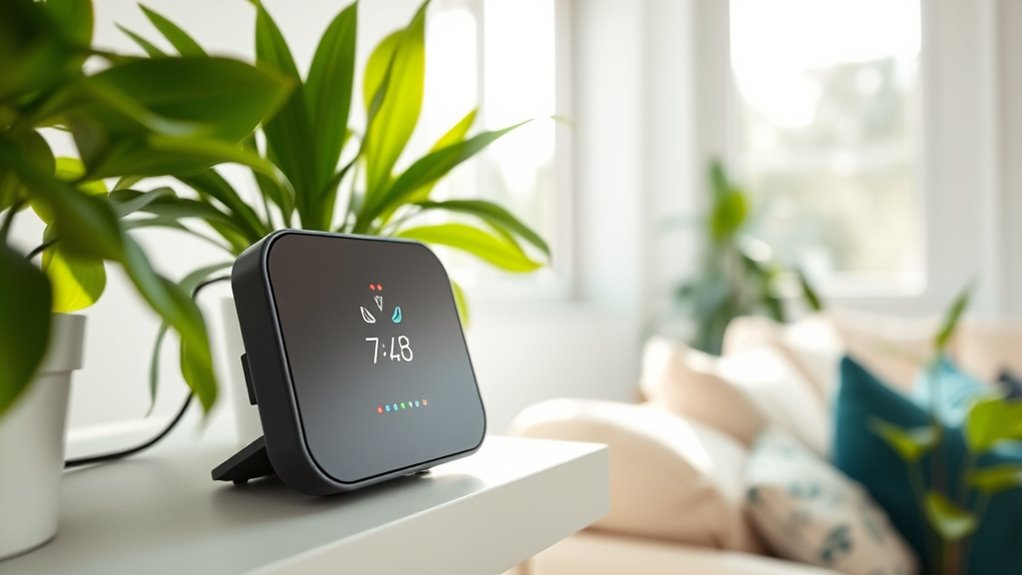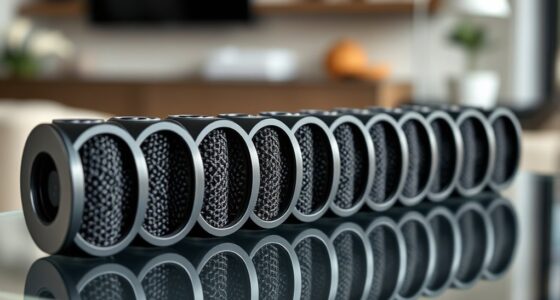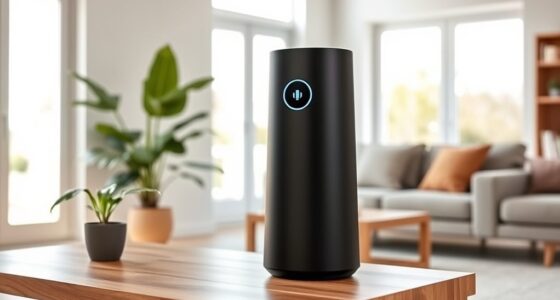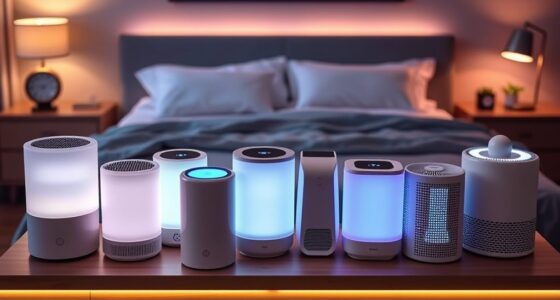If you’re looking to improve your home’s air quality in 2025, I recommend checking out multi-sensor IAQ monitors that offer real-time data on pollutants like CO₂, PM, VOCs, and formaldehyde. Devices with connectivity options such as Wi-Fi or Bluetooth guarantee easy integration into your smart home, with alerts and remote monitoring. From compact, portable units to advanced multi-sensor systems, you’ll find options to suit your needs. Keep exploring, and you’ll discover the best choices available now.
Key Takeaways
- Multi-sensor IAQ monitors detect key pollutants like CO₂, PM, VOCs, and formaldehyde, providing comprehensive indoor air quality data.
- They offer real-time updates, customizable alerts, and seamless integration with smart home systems such as Alexa, Google Home, and Apple HomeKit.
- Advanced sensors and dual-chip calibration ensure high accuracy within ±0.5 units, supporting precise pollution source identification.
- Stylish, portable designs with easy setup, remote monitoring, and alert functionalities enhance user experience and indoor safety.
- Secure data transmission, cloud connectivity, and regular firmware updates protect user data and ensure device reliability.
Indoor Air Quality Monitor with AQI Alerts and Portable Real-Time Detection
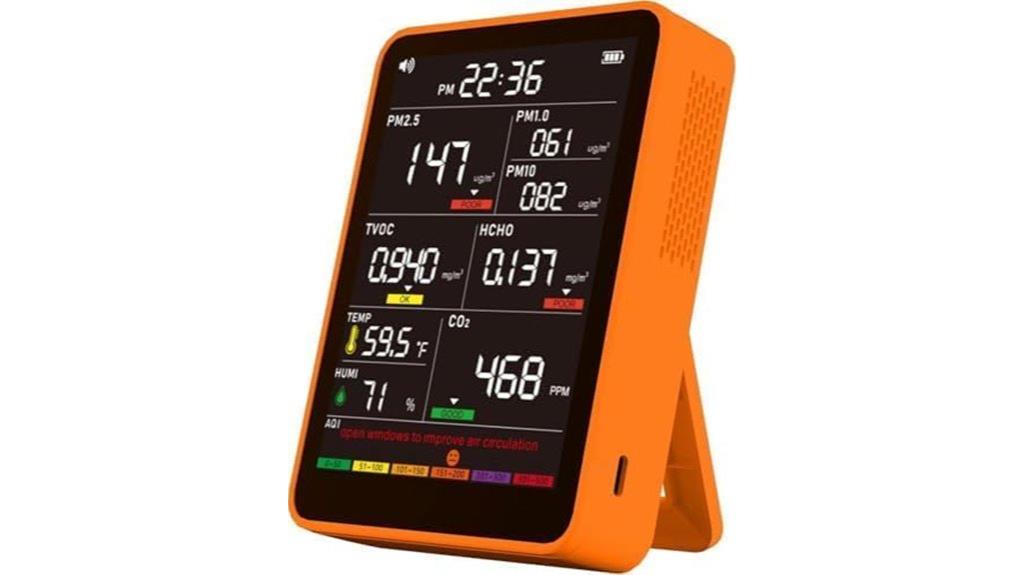
If you’re looking for a versatile and easy-to-use IAQ monitor that keeps you aware of your environment in real time, the Indoor Air Quality Monitor with AQI alerts is an excellent choice. Its sleek, modern design fits seamlessly in homes, cars, nurseries, or outdoor spaces. Compact and lightweight, I can easily move it between rooms or locations. Equipped with high-precision sensors, it detects PM levels, CO₂, TVOC, formaldehyde, temperature, and humidity every three seconds. The large HD display provides clear, visual data, while audible AQI alarms prompt quick action. Its portability, accuracy, and user-friendly interface make it ideal for maintaining healthier indoor air anywhere.
Best For: individuals seeking a portable, real-time indoor air quality monitor that provides accurate data and easy alerts for maintaining healthier environments at home, in vehicles, or outdoors.
Pros:
- High-precision sensors detect multiple air quality indicators every 3 seconds for real-time monitoring.
- Sleek, modern design with a large HD display and simple interface for easy readability and operation.
- Portable with rechargeable battery and fast charging, suitable for use in various locations and settings.
Cons:
- Battery life of 4-5 hours may require frequent recharging for extended use.
- Limited to indoor and nearby outdoor environments; not designed for long-term outdoor deployment.
- May be pricier than basic air quality detectors, given its professional-grade sensors and feature set.
UbiBot WS1-Pro WiFi Temperature Humidity Monitor
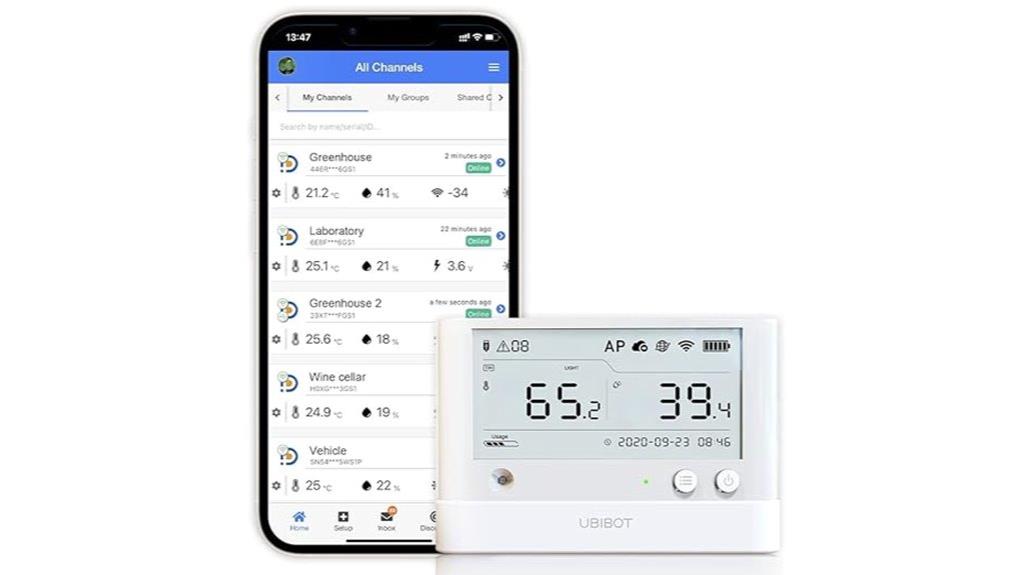
The UbiBot WS1-Pro WiFi Temperature Humidity Monitor stands out for its Swiss-engineered sensors that deliver highly accurate measurements of temperature, humidity, and light levels. It supports external probes, making it versatile for environments like greenhouses, labs, or refrigerators. The device offers real-time alerts for network issues, abnormal readings, or low batteries via email, app, API, or IFTTT, with optional SMS or voice calls. Full data access is free through the app and web console, ensuring secure remote management. Its flexible power options, LCD display, and compatibility with Alexa and IFTTT make it a reliable, easy-to-integrate solution for exhaustive environmental monitoring.
Best For: professionals and organizations needing precise, real-time environmental monitoring in sensitive settings like laboratories, greenhouses, or storage facilities.
Pros:
- Swiss-engineered sensors ensure highly accurate measurement of temperature, humidity, and light levels.
- Supports external probes for expanded environmental coverage and detailed monitoring.
- Offers versatile alert options via email, app, API, IFTTT, with optional SMS and voice calls for immediate notifications.
Cons:
- Requires WiFi connectivity, which may be unreliable in some environments.
- Additional fees may apply for SMS and voice call alerts.
- Limited to 4 AA batteries or USB power, which may necessitate frequent replacements or power management in certain setups.
Smart Home Energy Monitor with Circuit Sensors and Real-Time Tracking

For homeowners who want precise, real-time energy tracking integrated with their smart home systems, the Refoss Smart Home Energy Monitor stands out. It supports Home Assistant, offers detailed solar metering, and features 16x60A and 2x200A sensors for accurate data across various system types. Easy to install in most circuit panels, it provides real-time power, voltage, current, and power factor readings, with data stored locally for up to three years. Users can set alerts, export detailed reports, and automate energy use—like consuming excess solar power—helping cut costs and reduce emissions. Its compatibility and all-encompassing features make it a top choice for energy-conscious homeowners.
Best For: homeowners seeking comprehensive, accurate real-time energy monitoring with smart home integration and solar management capabilities.
Pros:
- Supports detailed energy data storage for up to three years, enabling long-term analysis and optimization.
- Integrates seamlessly with Home Assistant for automation and enhanced control.
- Features high-accuracy sensors suitable for various system types, including single-phase, split-phase, and three-phase systems.
Cons:
- Installation can be time-consuming and may involve wiring clutter in the breaker panel.
- Physical components like the Wi-Fi antenna may be fragile and require reinforcement.
- Initial setup and sensor configuration may be challenging for users unfamiliar with electrical systems or smart device integration.
Amazon Smart Air Quality Monitor – Know your air, Works with Alexa

Designed for smart home enthusiasts who want effortless air quality management, the Amazon Smart Air Quality Monitor stands out with its seamless integration with Alexa. It tracks five key indoor air factors—PM 2.5, VOCs, CO, humidity, and temperature—delivering real-time insights via a color-coded LED and the Alexa app. It sends notifications or announces alerts on Echo devices when air quality drops, so you’re always informed. You can automate routines to activate purifiers or fans based on readings, maintaining ideal conditions effortlessly. With simple setup and compatibility with Alexa-enabled devices, it makes managing indoor air quality straightforward and integrated into your smart home ecosystem.
Best For: smart home enthusiasts seeking effortless, integrated air quality management with real-time insights and automation capabilities.
Pros:
- Seamless integration with Alexa for easy setup and voice control
- Tracks five key indoor air factors for comprehensive monitoring
- Automates device control to maintain optimal air quality effortlessly
Cons:
- Limited to indoor use; not suitable for outdoor air quality monitoring
- Requires compatible Alexa devices for full functionality
- May need additional smart devices (like purifiers or fans) for automation to be fully effective
GoveeLife Smart Air Quality Monitor
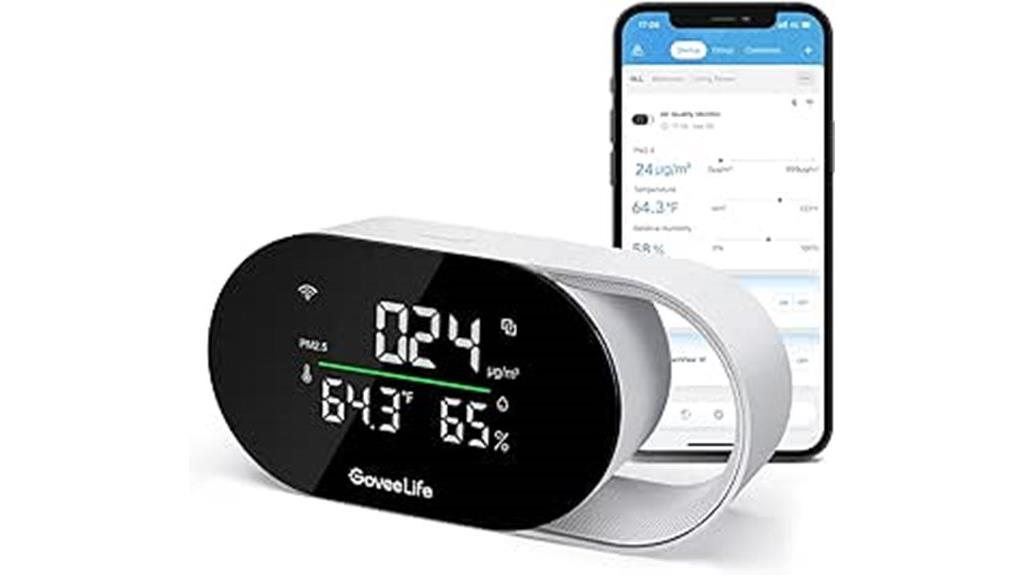
If you’re looking for an affordable yet reliable air quality monitor that integrates seamlessly into your smart home, the GoveeLife Smart Air Quality Monitor (H5106) is an excellent choice. Its compact, modern design fits easily into any space, and it features a clear LED display with modes like clock, PM2.5, bright, and night. It measures PM2.5, temperature, and humidity with quick updates every 2 seconds, supporting remote monitoring via Bluetooth and Wi-Fi. Compatible with GoveeHome devices, it can automate air purifiers, humidifiers, and heaters based on real-time data. Many users praise its accuracy and ease of use, though it lacks VOC and CO2 sensors.
Best For: homeowners and small office users seeking an affordable, easy-to-integrate air quality monitor with smart automation capabilities.
Pros:
- Accurate measurement of PM2.5, temperature, and humidity with quick 2-second updates
- Seamless integration with GoveeHome smart devices for automated air quality management
- Compact, modern design with an easy-to-read LED display suitable for various spaces
Cons:
- Lacks sensors for VOCs, CO2, and other pollutants, limiting comprehensive air quality assessment
- Occasional connectivity issues with Wi-Fi, especially on 2.4 GHz networks
- No support for certain smart appliances like recalled space heaters or sensors for outdoor pollutants
Indoor Air Quality Monitor, 8-in-1 Smart Tester with CO2, TVOC, HCHO, AQI, Temperature & Humidity
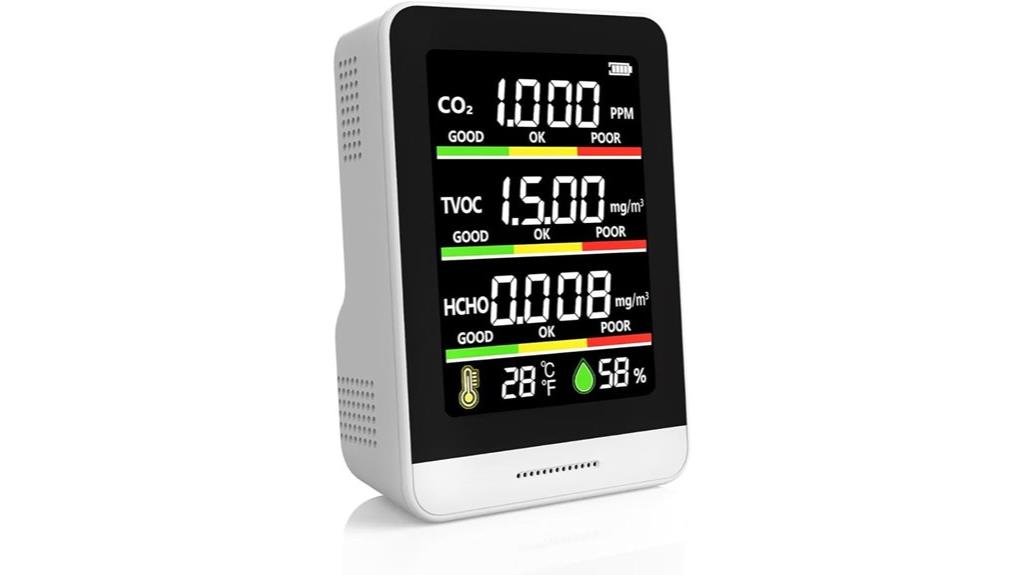
The Indoor Air Quality Monitor, 8-in-1 Smart Tester, stands out as an ideal choice for anyone seeking a thorough and user-friendly device to monitor multiple indoor pollutants simultaneously. It measures AQI, CO2, HCHO, TVOC, temperature, and humidity, providing real-time data on a clear, color-coded display. Compact and portable, it features a long-lasting battery and easy controls, making it perfect for various indoor spaces. With high-accuracy sensors and quick response times, it helps me identify hazards like formaldehyde or elevated CO2 levels instantly. Its simple interface and reliable readings make it an essential tool for maintaining healthy, comfortable indoor environments.
Best For: households, offices, and individuals seeking an easy-to-use, comprehensive indoor air quality monitoring device to ensure a healthy and comfortable environment.
Pros:
- High-precision sensors with quick response times for real-time data updates
- User-friendly interface with clear, color-coded display and simple controls
- Portable design with long-lasting battery suitable for multiple indoor spaces
Cons:
- Limited to indoor use; not designed for outdoor air quality monitoring
- Battery life of approximately 9-10 hours may require frequent recharging for extended use
- May be less effective in detecting very low pollutant concentrations beyond its specified range
Indoor Air Quality Monitor with AQI Alarms, Portable Real-Time Detector
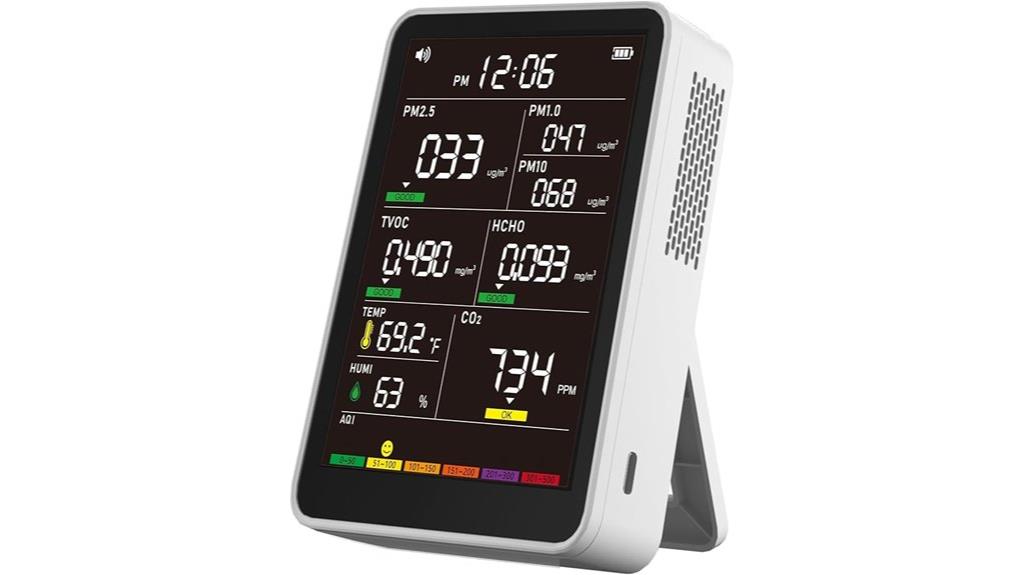
This portable indoor air quality monitor stands out for its all-encompassing 16-in-1 sensor suite, making it ideal for anyone who wants real-time, accurate data on their environment. Its sleek, stylish design in Snow White ensures it blends seamlessly into homes, offices, or cars. With a large HD display, it updates air quality data every three seconds, alerting me instantly to issues via seven different AQI alarms. Its compact size and fast Type-C charging deliver up to five hours of continuous use, providing peace of mind whether I’m at home or on the go. It’s a reliable, user-friendly device that helps me maintain a healthier indoor environment.
Best For: Individuals seeking a portable, comprehensive air quality monitoring device for their home, office, car, or nursery to ensure a healthier indoor environment.
Pros:
- 16-in-1 sensor suite provides detailed, real-time data on particles, gases, temperature, and humidity.
- Stylish, compact design with easy setup and intuitive controls suitable for all users.
- Long battery life of up to 5 hours with fast Type-C charging, ensuring reliable portability.
Cons:
- Battery life may be limited for extended outdoor use without frequent recharging.
- Some users might find the device’s advanced features overwhelming initially.
- Price may be higher compared to simpler air quality monitors with fewer sensors.
SIEMENS Inhab Smart Home Energy Monitor
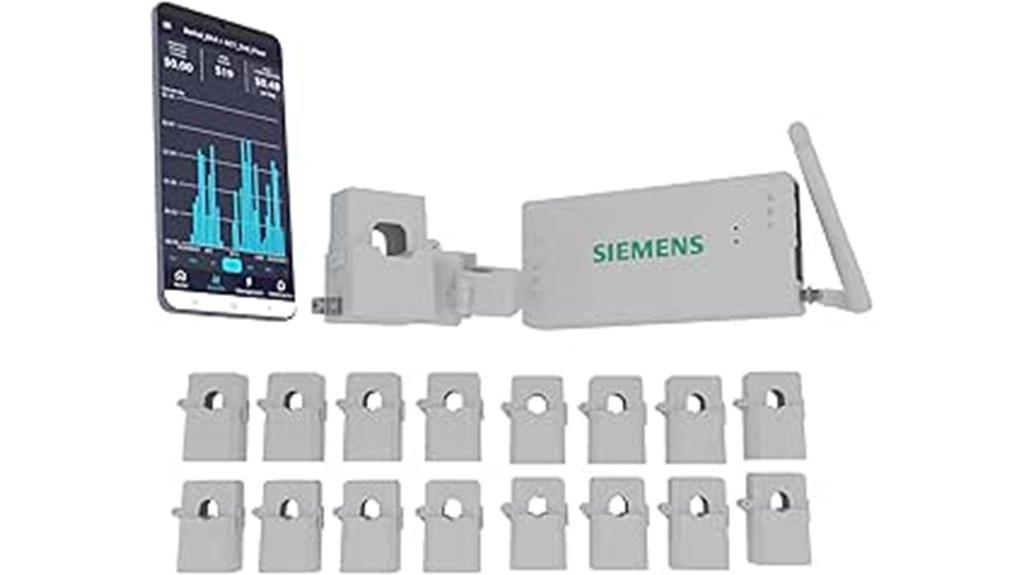
For homeowners seeking detailed energy insights with professional-grade installation, the Siemens Inhab Smart Home Energy Monitor stands out. It measures real-time household energy use and production, connecting directly to circuits like the furnace, AC, refrigerator, and EV charger. Supporting up to 16 circuits with advanced features like Time of Use Management, Peak Demand Control, and net metering, it helps optimize energy efficiency. The device includes sensors, transformers, and a user-friendly app for tracking consumption, alerts, and data export. While installation requires a licensed electrician and some wiring challenges, the monitor offers precise, extensive data to improve your home’s energy management in real time.
Best For: homeowners seeking detailed, real-time energy insights and professional-grade installation to optimize household energy management.
Pros:
- Supports comprehensive monitoring of up to 16 circuits with high-precision sensors and transformers.
- Offers advanced features like Time of Use Management, Peak Demand Control, and net metering for energy optimization.
- Provides detailed real-time and historical data through a user-friendly mobile app, aiding in energy savings.
Cons:
- Installation requires a licensed electrician and can be challenging in tight or complex panel layouts.
- Limited to 16 clamps, which may be insufficient for larger or more complex electrical systems.
- App access and regional restrictions may limit usability outside the USA and Canada, and data export can be cumbersome.
Smart Home Energy Monitor with 16 50A Circuit Level Sensors
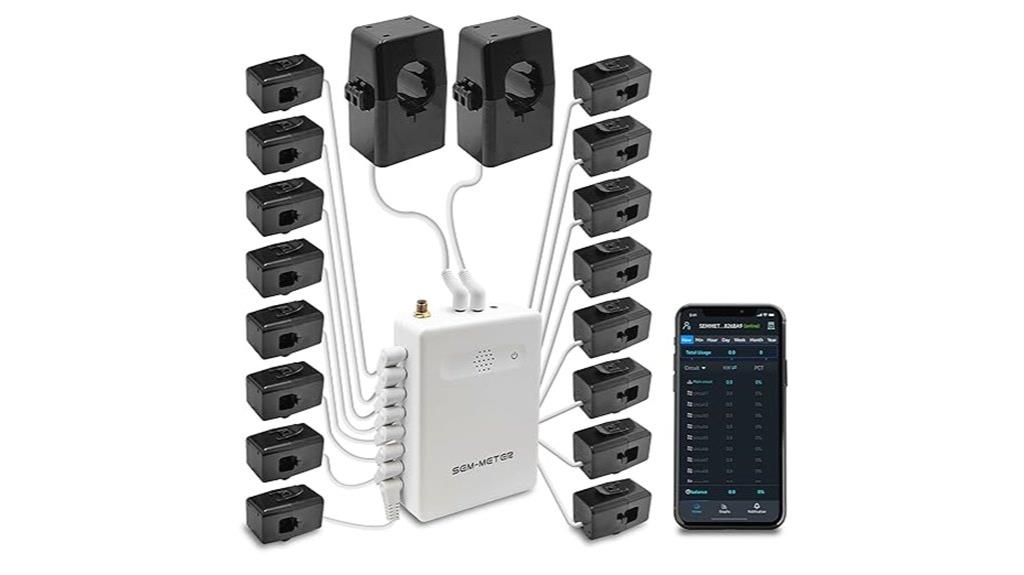
If you’re looking to optimize your home’s energy management with precise, real-time data, the Smart Home Energy Monitor with 16 50A circuit sensors stands out as an excellent choice. It supports various electrical systems, including single-phase and three-phase setups, and installs easily with clamp-on sensors. The device provides highly accurate measurements within 1.5%, comparable to professional meters, and allows monitoring of multiple appliances like ACs, water heaters, and ranges. With WiFi connectivity, you can access detailed data anytime through intuitive apps, set alerts, and export historical data—all while maintaining privacy with local MQTT support. It’s a powerful, cost-effective tool for smarter energy control.
Best For: homeowners and energy managers seeking precise, real-time energy monitoring and smart home integration across single-phase and three-phase electrical systems.
Pros:
- High accuracy measurements within 1.5%, comparable to professional-grade meters
- Flexible installation options with clamp-on sensors suitable for tight panels
- Supports local MQTT operation, ensuring privacy and seamless integration with home automation systems
Cons:
- Lacks a knockout grommet for WiFi antenna, requiring a workaround for installation
- Minor discrepancies in absolute readings compared to utility meters, though generally reliable
- Setup and configuration may require some technical familiarity, especially for MQTT integration
18-in-1 Indoor Air Quality Monitor with WiFi, Real-Time AQI, CO2, PM2.5, TVOC, HCHO, Temperature & Humidity
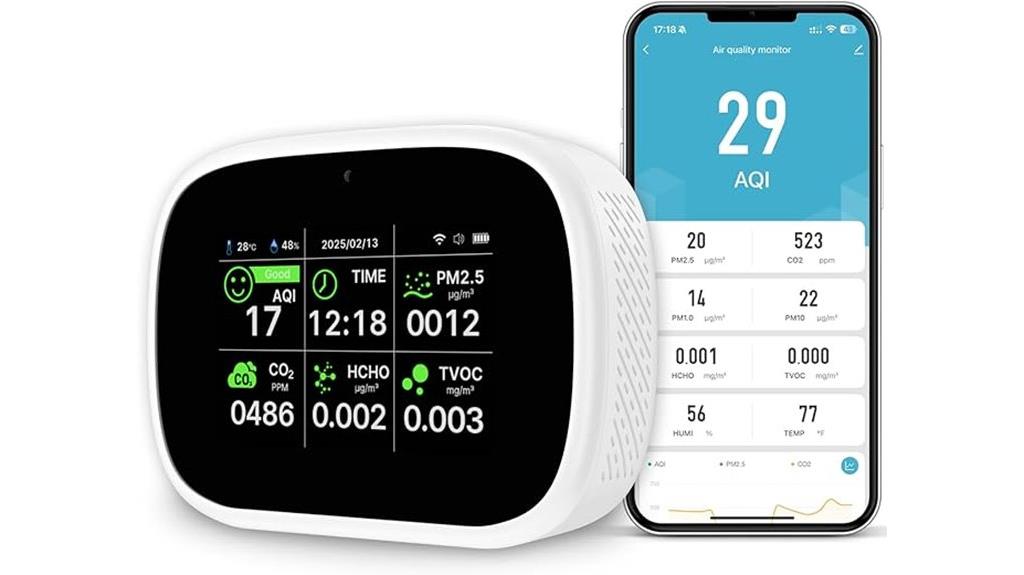
The in-1 Indoor Air Quality Monitor with WiFi stands out for its ability to provide real-time data on multiple air quality parameters, making it ideal for homeowners who want extensive, instant insights into their indoor environment. It detects 18 parameters, including AQI, CO2, PM2.5, TVOC, HCHO, temperature, and humidity, with high accuracy thanks to dual-chip technology. The device connects seamlessly via Wi-Fi to the Smart Life or Tuya Smart app, allowing remote monitoring, trend analysis, and alerts. Its bright HD display, wall-mount option, and rechargeable battery make it versatile and user-friendly, ensuring you stay informed and proactive about your indoor air quality.
Best For: homeowners, office managers, or anyone seeking comprehensive real-time indoor air quality monitoring to ensure a healthy living or working environment.
Pros:
- Detects 18 parameters, including AQI, CO2, PM2.5, TVOC, and HCHO, for thorough air quality assessment.
- Connects via Wi-Fi with app support for remote monitoring, trend analysis, and alerts.
- Features a bright HD LCD display with adjustable brightness and wall-mount capability for easy placement.
Cons:
- Limited battery life of 6-12 hours, requiring frequent recharging or continuous power supply.
- No adjustable screen brightness, which could affect visibility in different lighting conditions.
- USB-C port access requires removal of the rear cover, reducing convenience during setup or maintenance.
Smart Home Energy Monitor with Circuit Sensors and Real-Time Tracking
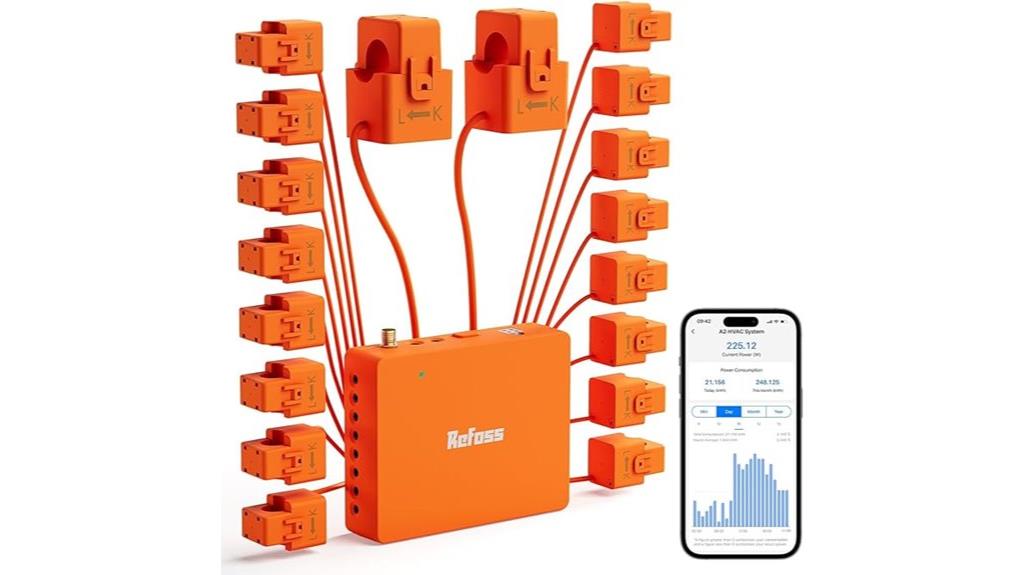
The Refoss Smart Home Energy Monitor stands out for homeowners seeking exhaustive, real-time energy management integrated seamlessly with home automation systems. With 16x60A circuit sensors and 2x200A main sensors, it supports single-phase, split-phase, and three-phase systems, offering precise data. Easy to install in most panel boxes, it connects via Wi-Fi and stores data locally for privacy. The monitor tracks power, voltage, current, and power factor, providing detailed insights and alerts for unusual spikes. It also integrates with solar setups, automating high-energy appliance use during surplus energy. Overall, it’s a thorough tool for optimizing energy use and reducing costs.
Best For: homeowners and energy enthusiasts seeking comprehensive real-time energy monitoring, solar automation, and seamless integration with home automation systems.
Pros:
- Supports multiple system types (single-phase, split-phase, three-phase) with high-accuracy sensors
- Local data storage ensures privacy and long-term energy usage analysis over up to 3 years
- Integration with Home Assistant and solar automation features optimize energy efficiency and cost savings
Cons:
- Installation can be time-consuming and may involve wiring clutter in the breaker panel
- Physical components like the Wi-Fi antenna may be fragile and require reinforcement
- Some users experience initial connectivity or sensor calibration issues that may require troubleshooting
16-in-1 Indoor Air Quality Monitor with Display and Alerts
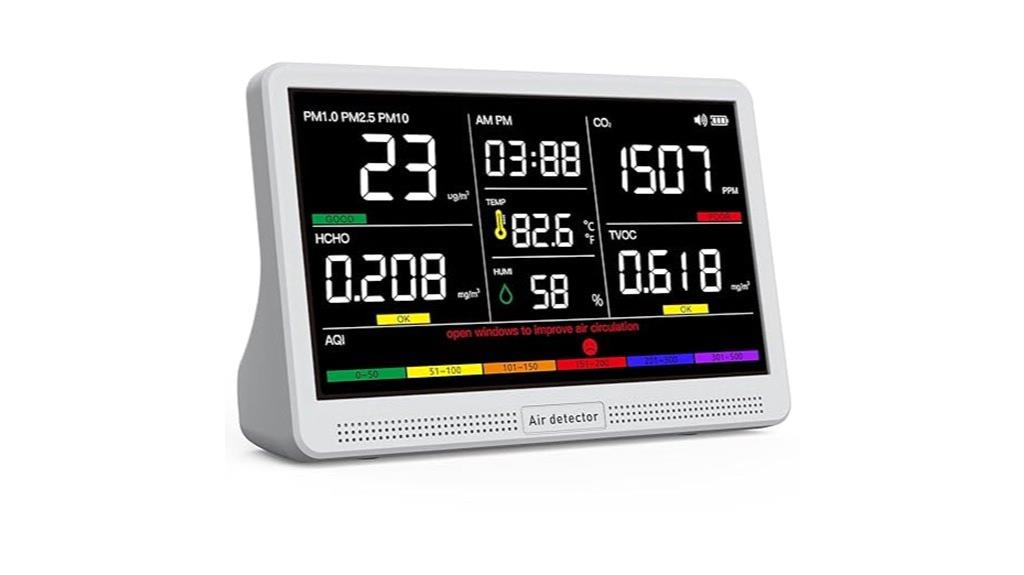
A standout choice for those seeking straightforward, real-time air quality monitoring without relying on smartphones or apps is the in-1 Indoor Air Quality Monitor with Display and Alerts. It detects nine key parameters, including CO2, PMs, VOCs, HCHO, temperature, humidity, and AQI, all shown on a clear 7-inch LED display. The device offers instant updates and customizable brightness, plus seven alert buzzers and color-coded indicators for quick understanding of air quality. Easy to set up by plugging into the wall, it provides reliable, high-precision readings that help me monitor pollutants effortlessly. It’s perfect for maintaining a safe, healthy indoor environment without complex setup.
Best For: individuals seeking a straightforward, real-time indoor air quality monitor with a clear display, no app dependency, and easy setup for maintaining a healthy environment.
Pros:
- Comprehensive detection of nine key air quality parameters with high-precision sensors
- Large, adjustable 7-inch LED display provides instant, clear readings without needing a smartphone app
- User-friendly setup with intuitive controls, alert buzzers, and color-coded indicators for quick interpretation
Cons:
- Operates primarily on wall power, limiting placement flexibility and requiring continuous electricity supply
- Some users report skepticism about the accuracy of CO2 readings compared to professional measurements
- Device size may be bulky for certain spaces, and battery backup offers limited runtime
Factors to Consider When Choosing a Multi‑Sensor IAQ Monitor for Smart Home
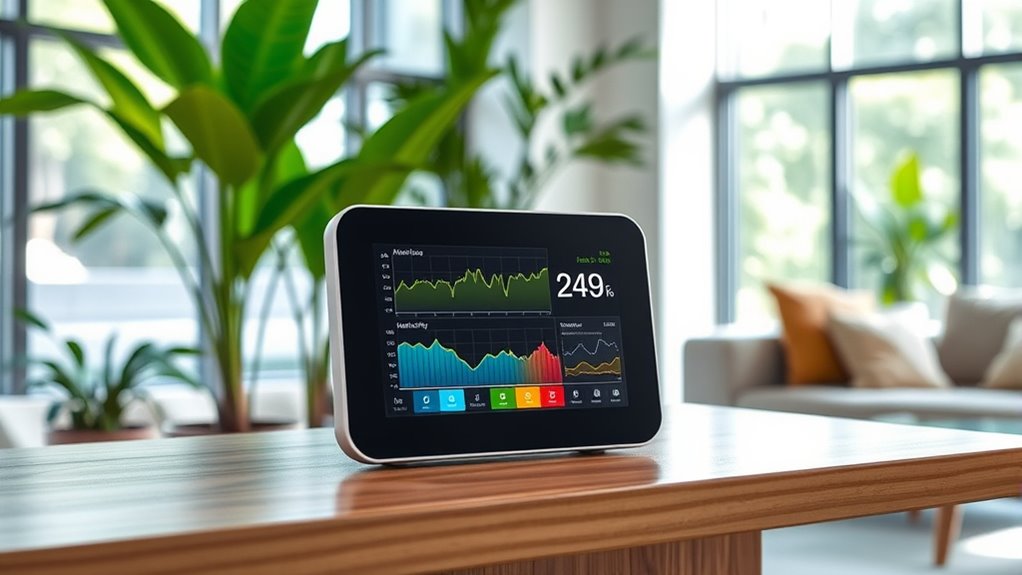
When choosing a multi-sensor IAQ monitor, I consider factors like sensor accuracy, detection range, and which parameters it can measure. Connectivity options and how easy it is to set up also matter, especially for seamless smart home integration. Ultimately, I look at power sources and battery life to guarantee reliable, long-term monitoring.
Sensor Accuracy and Range
Choosing a multi-sensor IAQ monitor hinges on its ability to deliver accurate readings, which depends on high-quality sensors with low measurement errors—usually within ±0.1 to ±0.5 units. These sensors must cover detection ranges suitable for typical indoor pollutant levels, such as 0-500 ppm for CO₂ and 0-1000 µg/m³ for PM2.5. It’s essential that the device detects a broad spectrum of pollutants, including gases like VOCs and formaldehyde, as well as particulates, temperature, and humidity, all within their respective ranges. Response time matters too, with faster sensors providing real-time updates. Additionally, choosing monitors with calibrated and verified sensors ensures sustained accuracy, offering reliable data you can trust for maintaining a healthy indoor environment.
Parameter Detection Capabilities
Selecting a multi-sensor IAQ monitor involves guaranteeing it can detect an all-inclusive set of parameters for a complete understanding of indoor air quality. I look for devices that measure PM1.0, PM2.5, and PM10 particles, along with gases like CO₂, TVOCs, and formaldehyde, to identify specific pollution sources. High-precision sensors with accuracy within ±15 µg/m³ for particulates and ±0.54°F for temperature give reliable readings. Real-time data updates every 2 to 3 seconds are essential for promptly catching air quality changes. The ability to detect both particles and gases ensures a thorough assessment, helping me pinpoint issues like chemical off-gassing or particulate buildup. A monitor with comprehensive parameter detection provides the insights needed to maintain a healthier indoor environment.
Connectivity and Integration Options
To make certain your multi-sensor IAQ monitor integrates smoothly into your smart home, it’s vital to check its connectivity options and compatibility with automation platforms. Look for support for popular protocols like Wi-Fi, Bluetooth, or Zigbee to ensure seamless integration with your existing ecosystem. Verify if the device works with platforms like Alexa, Google Home, or Apple HomeKit, so you can control it via voice commands and automate routines effortlessly. Consider whether it offers open APIs or supports protocols such as MQTT or HTTP, enabling custom integrations and advanced data management. Also, check if it connects to mobile apps and cloud services for remote monitoring, alerts, and data logging. Finally, see if it supports multi-device networking, allowing integration with other sensors and smart devices for a unified smart home system.
Ease of Setup
A multi-sensor IAQ monitor that’s easy to set up can save you time and frustration, especially if you’re not technically inclined. Look for devices with straightforward procedures, minimal steps, and no need for specialized knowledge. Features like quick installation, whether through simple mounting or plug-and-play design, let you start monitoring immediately. Clear instructions, visual guides, and intuitive controls make configuration quick and hassle-free, often taking just minutes. Wireless setup options via mobile apps or Wi-Fi considerably simplify the process compared to wired methods, allowing for seamless initial setup and adjustments later. Devices that support automatic calibration, preset settings, and require minimal user input will make ongoing use even easier, ensuring you get accurate readings without complicated setup procedures.
Power and Battery Life
Power and battery life are crucial factors when choosing a multi-sensor IAQ monitor for your smart home, as they directly impact convenience and ongoing performance. A good device should have a rechargeable battery offering at least 4-5 hours of wireless operation to guarantee portability and flexibility. Fast-charging via USB Type-C or similar ports is essential to minimize downtime and keep your monitor ready when needed. Battery life can vary based on sensor activity and display brightness, so opt for models with energy-efficient components to prolong usability. Devices primarily powered through AC should include backup batteries or surge protection to maintain operation during power outages. Overall, effective power management—like sleep modes and low-power sensors—ensures continuous operation without frequent recharging, keeping your indoor air quality monitored seamlessly.
Alarm and Alert Features
When selecting a multi-sensor IAQ monitor, it’s essential to take into account its alarm and alert features, as these directly impact your ability to respond quickly to air quality issues. Many devices include audible alarms and visual indicators that notify you immediately of dangerous levels of pollutants like PM2.5, CO2, VOCs, or formaldehyde. Customizable alert thresholds let you set specific limits tailored to your environment, ensuring you’re alerted only when necessary. Some monitors offer multiple alert types, such as buzzer sounds, push notifications, email alerts, or even integration with smart home systems, providing thorough coverage. Having multiple alert modes and distinct alarm signals helps you quickly identify and address different issues, which is especially essential in sensitive spaces like nurseries or homes with pets.
Device Durability and Design
Choosing the right IAQ monitor involves more than just its sensing capabilities; durability and design play a key role in guaranteeing long-term performance. A sturdy device should have a robust housing, like high-quality plastic or metal, to resist daily wear and environmental stress. Reinforced seams, secure mounting options, and protective covers help safeguard sensors and circuit boards from damage. Compact, ergonomic shapes make handling easier and reduce the risk of drops or accidents. For outdoor or semi-outdoor use, weather-resistant or sealed enclosures are essential to maintain reliability. A well-designed monitor also features intuitive controls and clear displays that resist dust, moisture, and impact, ensuring it stays functional and reliable over time. Prioritizing durability and thoughtful design ensures your investment lasts and performs as expected.
Data Management and Security
Ensuring the security of your air quality data is essential when selecting a multi-sensor IAQ monitor for your smart home. I recommend checking whether the monitor stores data locally or in the cloud, as local storage typically offers better security. Support for encrypted data transmission, like SSL or TLS, is critical to protect your sensitive information during remote access. Additionally, verify the device supports secure authentication protocols such as OAuth or two-factor authentication to prevent unauthorized access. Regular firmware updates are imperative for fixing security vulnerabilities and maintaining data integrity. Finally, look for monitors with transparent, open-source data management policies, so you can review how your environmental data is stored, shared, and handled, giving you peace of mind about your privacy and security.
Frequently Asked Questions
How Do Multi-Sensor IAQ Monitors Integrate With Existing Smart Home Systems?
You’re wondering how multi-sensor IAQ monitors connect with your existing smart home setup. I find that most integrate seamlessly via Wi-Fi or Zigbee protocols, allowing them to communicate with hubs like Alexa or Google Home. I simply link the monitor through an app, and it starts sharing real-time air quality data. Then, I can automate actions like turning on air purifiers or opening windows, making my home healthier effortlessly.
What Maintenance Is Required for Long-Term Accuracy of IAQ Monitors?
Thinking about long-term accuracy, I’ve learned regular maintenance is key. For example, I once ignored replacing filters in my monitor, and readings became unreliable. I check sensors periodically, clean them gently, and replace filters as recommended. Calibration is also vital—some devices need annual calibration to stay precise. Staying proactive ensures your IAQ monitor continues giving accurate data, helping you maintain a healthier indoor environment.
Can IAQ Monitors Detect Harmful Gases in Real-Time Effectively?
You’re wondering if IAQ monitors can detect harmful gases in real-time effectively. I believe they can, especially the latest multi-sensor models, which use advanced sensors to identify pollutants like carbon monoxide, VOCs, and radon quickly. These devices provide instant alerts, helping you respond promptly. However, their accuracy depends on proper calibration and maintenance, so regular checks guarantee they keep functioning effectively for your safety.
How Do Different Sensors in IAQ Monitors Prioritize Alerts and Notifications?
Oh, the joy of juggling alerts from different sensors—like detecting CO2 levels, humidity, and volatile organic compounds all at once! In my experience, monitors prioritize alerts based on severity, with toxic gases like carbon monoxide taking top priority. Less urgent notifications, like humidity dips, come second. It’s a clever system that makes sure I focus on what truly matters, even if I sometimes wish it had a snooze button.
Are Multi-Sensor IAQ Monitors Suitable for Commercial or Industrial Environments?
I believe multi-sensor IAQ monitors are quite suitable for commercial and industrial environments because they provide extensive data on various air quality factors like pollutants, humidity, and temperature. This helps in early detection of issues, ensuring safety and compliance. They’re robust, adaptable, and can handle larger spaces, making them an ideal choice for maintaining peak air quality in more complex settings.
Conclusion
If you’re serious about transforming your home into a sanctuary of pristine air, these monitors are your secret weapons—truly the Swiss Army knives of IAQ technology. They offer real-time insights that can elevate your indoor environment to levels previously thought impossible, making your home not just comfortable but a haven of health. Investing in one of these is like wielding a superhero’s power over your indoor air, ensuring every breath you take is pure perfection.
